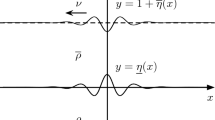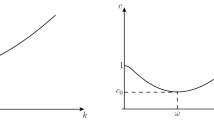Abstract
This paper studies the nonlinear stability of capillary-gravity waves propagating along the interface dividing two immiscible fluid layers of finite depth. The motion in both regions is governed by the incompressible and irrotational Euler equations, with the density of each fluid being constant but distinct. A diverse collection of small-amplitude solitary wave solutions for this system have been constructed by several authors in the case of strong surface tension (as measured by the Bond number) and slightly subcritical Froude number. We prove that all of these waves are (conditionally) orbitally stable in the natural energy space. Moreover, the trivial solution is shown to be conditionally stable when the Bond and Froude numbers lie in a certain unbounded parameter region. For the near critical surface tension regime, we prove that one can infer conditional orbital stability or orbital instability of small-amplitude traveling waves solutions to the full Euler system from considerations of a dispersive PDE model equation. These results are obtained by reformulating the problem as an infinite-dimensional Hamiltonian system, then applying a version of the Grillakis–Shatah–Strauss method recently introduced in Varholm et al. (Commun Pure Appl Math 73:2634–2684, 2020). A key part of the analysis consists of computing the spectrum of the linearized augmented Hamiltonian at a shear flow or small-amplitude wave. For this, we generalize an idea used by Mielke (R Soc Lond Philos Trans Ser A Math Phys Eng Sci 360:2337–2358, 2002) to treat capillary-gravity water waves beneath vacuum.


Similar content being viewed by others
References
Albert, J.P.: Positivity properties and stability of solitary-wave solutions of model equations for long waves. Commun. Partial Differ. Equ. 17, 1–22 (1992)
Amick, C.J., Kirchgässner, K.: A theory of solitary water-waves in the presence of surface tension. Arch. Rational Mech. Anal. 105, 1–49 (1989)
Amick, C.J., Toland, J.F.: Homoclinic orbits in the dynamic phase-space analogy of an elastic strut. Eur. J. Appl. Math. 3, 97–114 (1992)
Amick, C.J., Turner, R.E.L.: A global theory of internal solitary waves in two-fluid systems. Trans. Am. Math. Soc. 298, 431–484 (1986)
Amick, C.J., Turner, R.E.L.: Small internal waves in two-fluid systems. Arch. Ration. Mech. Anal. 108, 111–139 (1989)
Angulo Pava, J.: Nonlinear dispersive equations, vol. 156 of Mathematical Surveys and Monographs, American Mathematical Society, Providence, RI, 2009. Existence and stability of solitary and periodic travelling wave solutions
Benjamin, T.B.: The stability of solitary waves. Proc. R. Soc. (Lond.) Ser. A 328, 153–183 (1972)
Benjamin, T.B., Bridges, T.J.: Reappraisal of the Kelvin-Helmholtz problem. I. Hamiltonian structure. J. Fluid Mech. 333, 301–325 (1997)
Benjamin, T.B., Olver, P.J.: Hamiltonian structure, symmetries and conservation laws for water waves. J. Fluid Mech. 125, 137–185 (1982)
Benney, D.J.: A general theory for interactions between short and long waves. Stud. Appl. Math. 56, 81–94 (1976/77)
Bona, J.L., Bose, D.K., Turner, R.E.L.: Finite-amplitude steady waves in stratified fluids. J. Math. Pures Appl. (9) 62(1983), 389–439 (1984)
Buffoni, B.: Periodic and homoclinic orbits for Lorentz–Lagrangian systems via variational methods. Nonlinear Anal. 26, 443–462 (1996)
Buffoni, B.: Existence and conditional energetic stability of capillary-gravity solitary water waves by minimisation. Arch. Ration. Mech. Anal. 173, 25–68 (2004)
Buffoni, B.: Conditional energetic stability of gravity solitary waves in the presence of weak surface tension. Topol. Methods Nonlinear Anal. 25, 41–68 (2005)
Buffoni, B.: Gravity solitary waves by minimization: an uncountable family. Topol. Methods Nonlinear Anal. 34, 339–352 (2009)
Buffoni, B., Champneys, A.R., Toland, J.F.: Bifurcation and coalescence of a plethora of homoclinic orbits for a Hamiltonian system. J. Dyn. Differ. Equ. 8, 221–279 (1996)
Buffoni, B., Groves, M.D., Toland, J.F.: A plethora of solitary gravity-capillary water waves with nearly critical Bond and Froude numbers. Philos. Trans. R. Soc. Lond. Ser. A 354, 575–607 (1996)
Cazenave, T., Lions, P.-L.: Orbital stability of standing waves for some nonlinear Schrödinger equations. Commun. Math. Phys. 85, 549–561 (1982)
Champneys, A.R., Toland, J.F.: Bifurcation of a plethora of multi-modal homoclinic orbits for autonomous Hamiltonian systems. Nonlinearity 6, 665–721 (1993)
Chen, R.M., Walsh, S., Wheeler, M.H. : Center manifolds without a phase space for quasilinear problems in elasticity, biology, and hydrodynamics. arXiv preprint arXiv:1907.04370 (2019)
Chen, R.M., Walsh, S., Wheeler, M.H.: Global bifurcation for monotone fronts of elliptic equations. arXiv preprint arXiv:2005.00651 (2020)
Craig, W., Groves, M.D.: Normal forms for wave motion in fluid interfaces. Wave Motion 31, 21–41 (2000)
Devaney, R.L.: Homoclinic orbits in Hamiltonian systems. J. Differ. Equ. 21, 431–438 (1976)
Dey, B., Khare, A., Kumar, C.N.: Stationary solitons of the fifth order KdV-type. Equations and their stabilization. Phys. Lett. A 223, 449–452 (1996)
Dias, F., Iooss, G.: Capillary-gravity solitary waves with damped oscillations. Phys. D 65, 399–423 (1993)
Drazin, P.G., Reid, W.H. : Hydrodynamic Stability, Cambridge Mathematical Library, 2nd edn. Cambridge University Press, Cambridge (2004). With a foreword by John Miles
Grillakis, M., Shatah, J., Strauss, W.: Stability theory of solitary waves in the presence of symmetry. I. J. Funct. Anal. 74, 160–197 (1987)
Groves, M.D., Wahlén, E.: On the existence and conditional energetic stability of solitary water waves with weak surface tension. C. R. Math. Acad. Sci. Paris 348, 397–402 (2010)
Groves, M.D., Wahlén, E.: On the existence and conditional energetic stability of solitary gravity-capillary surface waves on deep water. J. Math. Fluid Mech. 13, 593–627 (2011)
Groves, M.D., Wahlén, E.: Existence and conditional energetic stability of solitary gravity-capillary water waves with constant vorticity. Proc. R. Soc. Edinb. Sect. A 145, 791–883 (2015)
Il’ichev, A.T., Semenov, A.Y.: Stability of solitary waves in dispersive media described by a fifth-order evolution equation. Theor. Comput. Fluid Dyn. 3, 307–326 (1992)
Iooss, G., Kirchgässner, K.: Bifurcation d’ondes solitaires en présence d’une faible tension superficielle. C. R. Acad. Sci. Paris Sér. I Math. 311, 265–268 (1990)
Iooss, G., Pérouème, M.-C.: Perturbed homoclinic solutions in reversible 1:1 resonance vector fields. J. Differ. Equ. 102, 62–88 (1993)
James, G.: Internal travelling waves in the limit of a discontinuously stratified fluid. Arch. Ration. Mech. Anal. 160, 41–90 (2001)
Kabakouala, A., Molinet, L.: On the stability of the solitary waves to the (generalized) Kawahara equation. J. Math. Anal. Appl. 457, 478–497 (2018)
Kawahara, T.: Oscillatory solitary waves in dispersive media. J. Phys. Soc. Jpn. 33, 260–264 (1972)
Kirrmann, P.: Reduktion nichtlinearer elliptischer systeme in Zylindergebeiten unter Verwendung von optimaler Regularität in Hölder-Räumen. Ph.D. thesis, Universität Stuttgart (1991)
Laget, O., Dias, F.: Numerical computation of capillary-gravity interfacial solitary waves. J. Fluid Mech. 349, 221–251 (1997)
Lannes, D.: A stability criterion for two-fluid interfaces and applications. Arch. Ration. Mech. Anal. 208, 481–567 (2013)
Lannes, D.: The Water Waves Problem, vol. 188. American Mathematical Society, Providence (2013)
Le, H.: Elliptic equations with transmission and Wentzell boundary conditions and an application to steady water waves in the presence of wind. Discrete Contin. Dyn. Syst. 38, 3357–3385 (2018)
Levandosky, S.P.: A stability analysis of fifth-order water wave models. Phys. D 125, 222–240 (1999)
Levandosky, S.P.: Stability of solitary waves of a fifth-order water wave model. Phys. D 227, 162–172 (2007)
Makarenko, N.I.: Smooth bore in a two-layer fluid, in Free boundary problems in continuum mechanics (Novosibirsk, 1991), vol. 106 of International Series of Numerical Mathematics, pp. 195–204. Birkhäuser, Basel (1992)
Mielke, A.: Homoclinic and heteroclinic solutions in two-phase flow. In: Proceedings of the IUTAM/ISIMM Symposium on Structure and Dynamics of Nonlinear Waves in Fluids (Hannover, 1994), vol. 7 of Advanced Series of Nonlinear Dynamics, pp. 353–362. World Scientific Publishing, River Edge (1995)
Mielke, A.: On the energetic stability of solitary water waves. R. Soc. Lond. Philos. Trans. Ser. A Math. Phys. Eng. Sci. 360, 2337–2358 (2002)
Nilsson, D.V.: Internal gravity-capillary solitary waves in finite depth. Math. Methods Appl. Sci. 40, 1053–1080 (2017)
Posukhovskyi, I., Stefanov, A.G.: On the normalized ground states for the Kawahara equation and a fourth order NLS. Discrete Contin. Dyn. Syst. 40, 4131–4162 (2020)
Reed, M., Simon, B.: Methods of Modern Mathematical Physics IV: Analysis of Operators. Academic Press, San Diego (1978)
Sandstede, B.: Instability of localized buckling modes in a one-dimensional strut model. Philos. Trans. R. Soc. Lond. Ser. A 355, 2083–2097 (1997)
Shatah, J., Zeng, C.: Geometry and a priori estimates for free boundary problems of the Euler equation. Commun. Pure Appl. Math. 61, 698–744 (2008)
Shatah, J., Zeng, C.: A priori estimates for fluid interface problems. Commun. Pure Appl. Math. 61, 848–876 (2008)
Shatah, J., Zeng, C.: Local well-posedness for fluid interface problems. Arch. Ration. Mech. Anal. 199, 653–705 (2011)
Sun, S.M., Shen, M.C.: A new solitary wave solution for water waves with surface tension. Ann. Mat. Pura Appl. (4) 162, 179–214 (1992)
Varholm, K., Wahlén, E., Walsh, S.: On the stability of solitary water waves with a point vortex. Commun. Pure Appl. Math. 73, 2634–2684 (2020)
Acknowledgements
The research of RMC is supported in part by the NSF through DMS-1907584. The research of SW is supported in part by the NSF through DMS-1812436. The authors would also like to thank Dag Nilsson for enlightening communications regarding the existence theory in Sect. 3.5, and Daniel Sinambela for close readings of earlier versions of the manuscript.
Author information
Authors and Affiliations
Corresponding author
Ethics declarations
Data availability statement
Data sharing not applicable to this article.
Additional information
Communicated by A. Ionescu
Publisher's Note
Springer Nature remains neutral with regard to jurisdictional claims in published maps and institutional affiliations.
Appendix A. Elementary Identities
Appendix A. Elementary Identities
Here we give the proofs of the elementary first and second derivative formulas for the nonlocal operators \(G_\pm (\eta )\) and \(A(\eta )\).
Proof of Lemma 3.3
The formula (3.18) for \(D G_\pm (\eta )\) can be derived using the same method as the standard one-fluid case. To obtain (3.20), it is easier to first consider the derivative of
Then,
Using the self-adjointness of \(G_\pm (\eta )\) and the formula (3.18) for \(D G_\pm (\eta )\), this leads immediately to (3.20). \(\square \)
Proof of Lemma 3.6
As in the proof of Lemma 3.3, we start by considering the corresponding formula for \(A(\eta )^{-1}\). Recalling (A.1), we see that
On the other hand, we have the elementary identity
Together, these will furnish a representation formula for the second variation of \(A(\eta )^{-1}\) once we have fully expanded these expressions using (3.18) and (3.21).
Consider each of the terms on the right-hand side of (A.2). For the first, we have
where recall that \(\theta _\pm = \theta _\pm (\eta , \psi )\) is given by (3.24). Throughout the remainder of the proof, \(a_i^\pm \) will always be evaluated at \((\eta , \theta _\pm )\), so we suppress the arguments for readability. By the first variation (3.18) and second variation (3.21) formulas for \(G_\pm (\eta )\), this becomes
for the linear operator \({\mathscr {L}}_\pm \) given by (3.25). Using (3.18) once more allows us to simplify this to
So finally we have
where recall \(a_4 = a_4(\eta ,\psi )\) and \({\mathscr {M}} = {\mathscr {M}}(\eta ,\psi )\) were defined in (3.24) and (3.26), respectively.
Likewise, the second in term on the right-hand side of (A.2) can be treated as follows. Using (3.20), we calculate that
Applying (3.20) once more then yields
with \({\mathscr {N}} = {\mathscr {N}}(\eta ,\psi )\) defined in (3.27). Combining this with (A.2) and (A.3) gives the formula (3.23), completing the proof. \(\square \)
Rights and permissions
About this article
Cite this article
Chen, R.M., Walsh, S. Orbital Stability of Internal Waves. Commun. Math. Phys. 391, 1091–1141 (2022). https://doi.org/10.1007/s00220-022-04332-x
Received:
Accepted:
Published:
Issue Date:
DOI: https://doi.org/10.1007/s00220-022-04332-x




